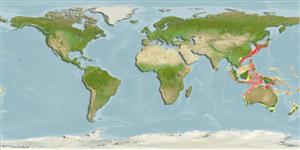Actinopterygii (ray-finned fishes) >
Scorpaeniformes (Scorpionfishes and flatheads) >
Bembridae (Deepwater flatheads)
Etymology: Bembras: Greek, bembras, -ados = a kind of anchovy (Ref. 45335).
Environment / Climate / Range
Ecology
Marine; demersal; depth range 80 - 230 m (Ref. 27966). Temperate, preferred ?
Indo-West Pacific: southern Japan and East China Sea. Specimens recorded from Indonesia, the Arafura Sea (Ref. 9819) and northwestern Australia (Ref. 5978) are probably new species (Ref. 13666).
Size / Weight / Age
Maturity: Lm ? range ? - ? cm
Max length : 30.0 cm SL male/unsexed; (Ref. 559)
Anal
spines: 0;
Anal
soft rays: 13 - 14. Head depressed. Body without large scute-like spines. Infraorbital bones forming a strong ridge, confluent with uppermost preopercular spine and having 4-6 spines. Ratio of pectoral-fin length to caudal fin length 0.88 to 1.05 (Ref. 40506).
Found in the continental shelf (Ref. 7300). Inhabit sand or sandy mud bottoms (Ref. 11230). Neither anterolateral glandular groove nor venom gland is present (Ref. 57406).
Life cycle and mating behavior
Maturity | Reproduction | Spawning | Eggs | Fecundity | Larvae
Imamura, H. and L.W. Knapp, 1998. Review of the genus Bembras Cuvier, 1929 (Scorpaeniformes: Bembridae) with description of three new species collected from Australia and Indonesia. Ichthyol. Res. 45(2):165-178. (Ref. 27966)
IUCN Red List Status (Ref. 115185)
CITES (Ref. 94142)
Not Evaluated
Threat to humans
Harmless
Human uses
More information
Common namesSynonymsMetabolismPredatorsEcotoxicologyReproductionMaturitySpawningFecundityEggsEgg development
ReferencesAquacultureAquaculture profileStrainsGeneticsAllele frequenciesHeritabilityDiseasesProcessingMass conversion
Tools
Special reports
Download XML
Internet sources
